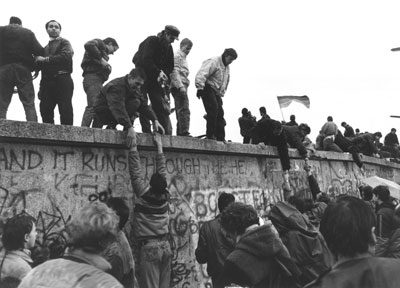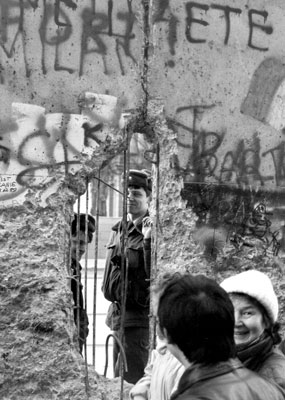The Wall
This item appears on page 62 of the May 2009 issue.
by Jay Brunhouse
In 1984, my train from West Germany, the Federal Republic, to West Berlin passed through 112 miles of ominous countryside known as the German Democratic Republic. The armed guards and police dogs patrolling the platforms along with the barbed-wire fences lining the tracks made everyone nervous.
The trains, by and large, were delayed, but my train, No. D-345, known to passengers as the “Paranoia Express,” traveled on time through Hannover and crossed the East German border at Helmstedt. The border crossing was scheduled for 11 minutes.
Once out of Helmstedt, passport inspectors, Customs officials and ticket takers came through the carriages in waves. I received a bold “DDR” (Deutsche Demokratische Republic) stamp on my passport and a separate transit visa.
The train’s first stop was in Berlin at Wannsee Station, but the mass exodus came at Berlin’s Zoo Station. The train continued to East Berlin’s Friedrichstraße Station empty.
The momentous fall of the Berlin Wall changed all that — and history.
November 9, 2009, will mark the 20th anniversary of the fall of the Berlin Wall and the peaceful revolution that led to it. To observe the anniversary, the city of Berlin has arranged a series of special events, starting on May 7 with an open-air exhibition on Alexanderplatz focusing on the events of 1989-’90 prior to the fall of the Wall.
Museums, including the German Historical Museum, the Allied Museum (with the original Checkpoint Charlie shack), the Stasi Museum and the DDR Museum each will feature distinct showings on this era of history. The Kennedy Museum, on Pariser Platz opposite the Brandenburg Gate, will put a tear in your eye and a lump in your throat.
Exhibitions and functions relating to the division of Germany and Berlin, the Cold War and the circumstances leading to the Reunification will culminate with an extravaganza at Brandenburg Gate on Nov. 9.
Nasty surprise
At 1 a.m., Aug. 13, 1961, when most Berliners were sleeping, East German workers began building the Wall. Guards unrolled bales of barbed wire, masons cemented closed the windows of houses fronting on the West and bulldozers forced into place the foundations of what came to be an effective barrier between East and West Berlin. At 1:30 a.m., S-Bahn and U-Bahn cross-city train connections were interrupted and 68 of the 80 road crossings were closed.
Several hours passed before Berliners and the rest of the world learned of this nasty surprise on the radio and television and in newspaper extras. It was a Sunday. Authorities in West Berlin, Bonn and Washington were caught completely unawares as the East German government sealed off the original Soviet sector.
The initial breeze blocks were replaced by heavy reinforced concrete sections, each of which was 11.7 feet high, four feet wide and six inches thick and weighed 2.5 tons. The Wall was topped by a thick rounded cap that was later crowned with barbed wire.
During the previous nine years, 1.5 million East German citizens, mostly young and skilled, had left their country for the high wages and creature comforts of West Germany’s Economic Miracle. The exodus, which had reached 30,000 a month, was robbing East Germany of a substantial part of its working population, causing an increasingly widespread shortage of labor and turning the German Democratic Republic into a nation of old-age pensioners.
The June 1961 summit meeting between Khrushchev and Kennedy in Vienna had been a disaster, so the East German government concluded that its best course was to close the border with West Berlin. They planned a physical barrier supported by 252 watchtowers and 136 bunkers to separate Berlin for a length of 27 miles and surround the city of West Berlin for a total length of 97 miles. The barrier blocked 62 city streets and 131 roads.
Before the Wall, there were 81 crossing points between the East and West Berlin sectors; afterward there were eight, including one for mail vans and one for coffins that were allowed through on Wednesdays. All U- and S-Bahn crossings were closed except for the notorious Friedrichstraße Station.
Panic
The instant the Berlin Wall began to rise across from the Reichstag, there was a last-minute flight of citizens determined to jump over the barbed-wire barricades, clamber over the walls a-forming, leap from still-open windows and sprint through sewers and underground train tunnels. There was a frenzy of tunneling below street level. In all, 80 people are known to have been killed. The last fatality occurred in February 1989, only a few months before the opening of the Wall.
Once the East was opened, hammers, crowbars and pickaxes appeared from storage. Wessis (West Berliners) chipped away at the concrete starting at the Reichstag, where it had stood 13 feet high. Mauerspechten (Wall woodpeckers) hammered to oblivion concrete walls, caged dog courses and observation towers. After the fall of the Wall, Berliners left only fragments intact.
Ossis (East Berliners) protested that Wessis couldn’t sell chunks of the suddenly valuable souvenir Wall: “It’s our Wall.” Vendors, including Russian soldiers, sold chunks of rock on collapsible card tables lining the tourist hubs near the former Checkpoint Charlie and the Brandenburg Gate. The more traces of purported graffiti per rock, the greater was its sales price. Who knows whether the coloring was daubed the previous night in some artist’s atelier? About one in 10 Germans has a chunk at home.
Everyone wants to see the Wall. It’s usually a first-time visitor’s first request. Sadly, for visitors — or happily for Berliners — there isn’t much left of the Wall to see, but you can find preserved segments here and there.
Information columns along the former course of the Wall in the city center tell the story of the division and of the building and fall of the Wall. Visualize a grim, hostile Wall towering between the Reichstag and the Brandenburg Gate and, equally shocking, between the staid Cultural Forum and lively Potsdamer Platz.
On the information columns, photographs, texts in four languages and audio information in eight languages describe the events that took place at the respective locations.
Wall Memorial
The only place in Berlin where you can see complete remains of the Wall with all its elements, such as the anterior wall, the death strip, guard paths, lighting and posterior wall, is on the border between the West Berlin district of Wedding and the East Berlin district of Prenzlauer Berg, at the corner of Gartenstraße and Bernauerstraße opposite the Nordbahnhof (North Train Station).
The US$1.2 million Gedenkstätte Berliner Mauer (Berlin Wall Memorial) was opened on Aug. 13, 1998, the 37th anniversary of the day the Wall went up. This 230-foot stretch of Wall is flanked at right angles by two 23-foot-high steel walls.
There is no access to the former death strip. It can be seen only through observation slits in the backup wall, which was built behind the Berlin Wall proper. The slits also provide visual access to a closed-off area, which is designed to symbolize the oppressive atmosphere of the death strip.
But construction was controversial. The Berlin Senate wanted to create a memorial that would reflect the inherent brutality and contempt for man. Who wanted THAT on the street across from their house?! Especially residents who had to accept for decades the real thing?
The second problem was that politicians got involved, even down to the detail of the wording of the memorial plaque, which, in its final version, they changed to read, “In memory of the division of the city from August 13, 1961, until November 9, 1989, and to the memory of the victims of Communist despotism.”
The architects were furious. They wanted to know “which victims?” Stalinism in general? The Communist government in China? Cuba?
Documentation Center
Across the street from the Wall Memorial, at Bernauerstraße 111, politicians opened the Berlin Wall Documentation Center on the 10th anniversary of the fall of the Wall, Nov. 9, 1999. In addition to the documentary exhibition, the venue offers a visitors’ digital archive, a reading station and listening stations with original soundtracks and statements by witnesses, as well as film and photo stations.
Across Ackerstraße, the Kapelle der Versöhnung, or Chapel of Reconciliation, rises above the site of the former Church of Reconciliation, which had lain in the “no man’s land” of the border area and had been inaccessible to its Protestant Reconciliation Congregation, which had also been divided into East and West.
In order to complete border defenses, the East German army blew up the church. After the fall of the Wall, the congregation built the austerely simple Chapel of Reconciliation on the foundations of the former church. The church bells, which had been preserved, are in front of the chapel, and the altar, which also was saved, stands inside the chapel.


